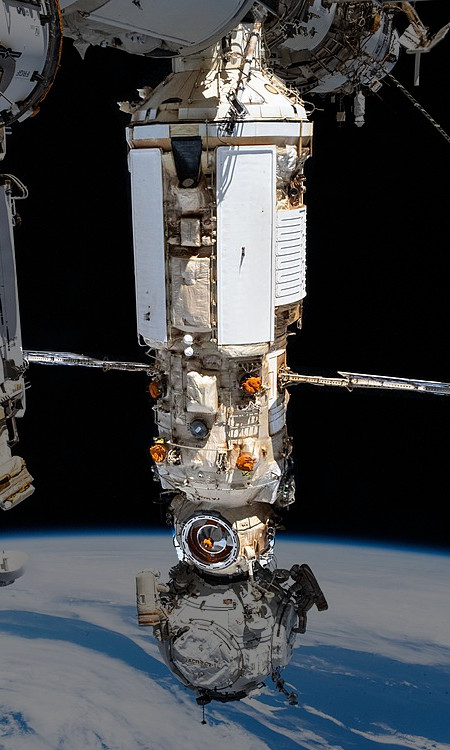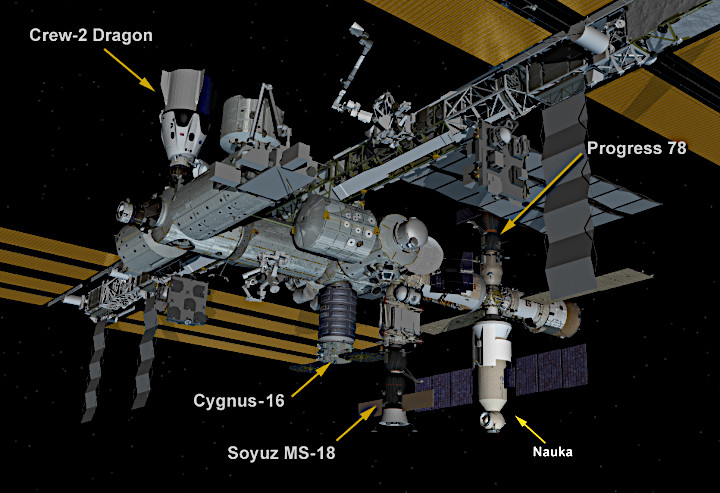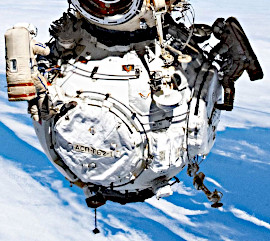
Nauka is docked to the nadir (bottom) port of Zvezda (SM). It replaces Pirs (DC-1). The Prichal Nodal Module is docked to Nauka's nadir port.


Nauka is docked to the nadir (bottom) port of Zvezda (SM). It replaces Pirs (DC-1). The Prichal Nodal Module is docked to Nauka's nadir port.

Nauka, also known as the Multipurpose Laboratory Module-Upgrade (MLM-U or simply Multipurpose Laboratory Module (MLM), is a habitable module of the ISS. It is funded by Roscosmos.
In the original ISS plans, Nauka was to use Zarya's nadir port. This port, however, is currently used by Mini Research Module 1, Rassvet. Nauka location was therefore moved to Zvezda's nadir port. This required the undocking and eventual destruction of Docking Compartment 1, Pirs.

Nauka was initially planned for launch 2007 but was repeatedly delayed. It was finally launched on 21 July 2021, along with the European Robotic Arm, and successfully docked on 29 July 2021. This was the first major expansion of the Russian ISS segment in over 20 years.
After Nauka docked, for unknown reasons, it began firing its engine thrusters. This caused the entire ISS to make one and a half full rotations before the thrusters ran out of fuel. Ground controllers and the crew were then able to stop the rotation and get the station back to its original position. According to NASA, the ISS crew was never in danger.
On 26 July Docking Compartment 1. Pirs was undocked from the ISS for the last time. Controllers then sent the de-orbit command and Pirs entered the atmosphere over the Pacific Ocean in a 17 minute burn. Pirs and the trash that was inside it burned up as it entered the atmosphere.
This was the first ISS permanent module to be decommissioned and destroyed.
On 29 July 2021, Nauka automatically docked and successfully attached to the station.
Nauka is now the primary science laboratory of the Russian Orbital Segment, operating in conjunction with the Mini-Research Modules Rassvet and Poisk. It is based on the Functional Cargo Block (FGB) design similar to Zarya and can serve as a backup Service Module, Zvezda.
The original 1990's plan for the Russian Orbital Segment included two Russian Research Modules and a Universal Docking Module located at the Service Module Zvezda's nadir port. These were to be based on the FGB Zarya's design.
A backup module for Zarya, called FGB-2, was already in production and would be used as the Universal Docking Module. Its construction, however, was halted at 70% completion in the late 1990s.
In 2004 it was decided to scrap the two research modules in favour of flying FGB-2 as a single research module known as Nauka. In 2005, Russia made a deal with the ESA to launch their European Robotic Arm with Nauka, with its spare elbow joint to launch with Mini Research Module Rassvet.
Nauka was planned for launch in 2007, however multiple delays pushed the date to 2021.
Reference: Wikipedia - Nauka | Russian Space Web - Nauka
A European Robotic Arm (ERA) is located on Nauka's exterior. The arm supplements the two Russian Strela cargo cranes that were originally installed on the Pirs module, but later moved to the docking compartment Poisk and Zarya module.
The ERA was developed for the European Space Agency (ESA) by a number of European space companies. In 2010, a spare elbow joint for the arm was launched preemptively, attached to Mini Research Module 1. Rassvet.
The ERA enables the installation, removal or replacement of external experiment payloads; the transfer of payloads through the science airlock and visual inspections of the station.
It can also support spacewalks by providing foot restraints, tether points, and control panels both on the inside and outside of the station.
Reference: Wikipedia - European Robotic Arm
Nauka is 13.12 m long and 4.25 m wide with a total mass of 20,350 kg. It is made of stainless steel, aluminium alloy, kevlar, and ceramic-wool insulation.
It has two SSVP-M docking ports; the passive nadir port is used to attach the Prichal Nodal Module to the station, while the active zenith port is used to attach Nauka to Zvezda's nadir port.
Nauka contains life support equipment including an oxygen production system capable of supporting six crew, a galley, a toilet with a urine recycling system, and one of the three sleep stations aboard the Russian Orbital Segment.
There is also a large observation window similar to Destiny nadir window on the aft side of the docking sphere, towards the nadir port. Also one small window hatch is on the forward port for the airlock module, similar to the two windows on the Kibo Pressurized Module.
Full guidance and navigation control, enabled by an attitude control system thrusters, provides roll control to the station. Nauka'sa advantageous position far from the station's fore-aft axis provides the greatest mechanical advantage for roll corrections of the station.
Nauka is also able to collect and store propellant delivered by Progress spacecraft and transfer it to Zvezda.
* Environment: Pressurised
* Length: 13.12 m
* Diameter: 4.25 m at widest point
* Mass: 20,357 kg in orbit
* Pressurized Volume: 80.9 m 3
* Habitable Volume: 70 m 3
The diagram below shows Nauka's location on Zvezda's nadir port. Also shown are the spacecraft docked to the station at the time of Nauka's installation.
Note: The Prichal Nodal Module is not shown.


The Prichal nodal module is a Russian component of the ISS. It was launched on 24 November 2021 attached to a Progress M-UM by a Soyuz 2.1b launcher.
The un-piloted progress craft was used to fly Prichal to the ISS and berth it to Nauka's nadir docking port.
Prichal will increase the number of available docking ports on the Russian Orbital Segment by four.